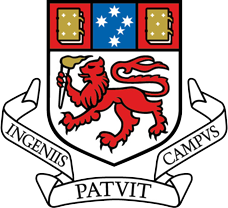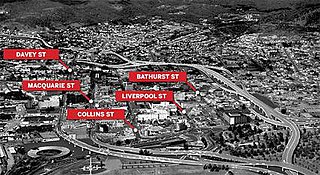
Hobart is the capital and most populous city of the Australian island state of Tasmania. Home to almost half of all Tasmanians, it is the least-populated Australian state capital city, and second-smallest if territories are taken into account, before Darwin, Northern Territory. Hobart is located in Tasmania's south-east on the estuary of the River Derwent, making it the most southern of Australia's capital cities. Its skyline is dominated by the 1,271-metre (4,170 ft) kunanyi/Mount Wellington, and its harbour forms the second-deepest natural port in the world, with much of the city's waterfront consisting of reclaimed land. The metropolitan area is often referred to as Greater Hobart, to differentiate it from the City of Hobart, one of the five local government areas that cover the city. It has a mild maritime climate.

Launceston is a city in the north of Tasmania, Australia, at the confluence of the North Esk and South Esk rivers where they become the Tamar River (kanamaluka). Launceston has a population of 87,645 (2021). Launceston is the second most populous city in Tasmania after the state capital, Hobart, As of 2020, Launceston is the 18th largest city in Australia. Launceston is fourth-largest inland city and the ninth-largest non-capital city in Australia. Launceston is the most liveable regional city, and was one of the most popular regional cities to move to in Australia from 2020 to 2021. Launceston won the Australian town of the year in 2022.
The history of Tasmania begins at the end of the most recent ice age when it is believed that the island was joined to the Australian mainland. Little is known of the human history of the island until the British colonisation in the 19th century.

The University of Tasmania (UTAS) is a public research university, primarily located in Tasmania, Australia. Founded in 1890, it is Australia's fourth oldest university. Christ College, one of the university's residential colleges, first proposed in 1840 in Lieutenant-Governor Sir John Franklin's Legislative Council, was modeled on the Oxford and Cambridge colleges, and was founded in 1846, making it the oldest tertiary institution in the country. The university is a sandstone university, a member of the international Association of Commonwealth Universities, and the Association of Southeast Asian Institutions of Higher Learning.

The Brooker Highway is a highway in the State of Tasmania, Australia. As one of Hobart's 3 major radials, the highway connects traffic from the Hobart city centre with the northern suburbs and is the major road connection to the cities and towns of Northern Tasmania. With an AADT of 48,000, the highway is one of the busiest in Tasmania. The Brooker Highway has recently been declared part of the National Highway.

Glenorchy City Council is a local government body in Tasmania, and one of the five municipalities that constitutes the Greater Hobart Area. The Glenorchy local government area has a population of 47,636, covering the suburbs north of central Hobart on the western shore of the Derwent River, including its namesake suburb, Glenorchy.

Sullivans Cove is on the River Derwent adjacent to the Hobart City Centre in Tasmania. It was the site of initial European settlement in the area, and the location of the earlier components of the Port of Hobart.

The Sydney central business district (CBD) is the historical and main commercial centre of Sydney. The Sydney CBD is Sydney's city centre, or Sydney City, and the two terms are used interchangeably. The CBD or city centre is often referred to simply as "Town" or "the City". The Sydney city centre extends southwards for about 3 km (2 mi) from Sydney Cove, the point of first European settlement in which the Sydney region was initially established. Due to its pivotal role in Australia's early history, it is one of the oldest established areas in the country.

The Royal Hobart Hospital is a public hospital in the Hobart CBD, Tasmania, Australia. The hospital also functions as a teaching hospital in co-operation with the University of Tasmania. The hospital's research facilities are known as the Royal Hobart Hospital Research Foundation. Also close to the hospital site is the Menzies Research Institute.

TheMercury is a daily newspaper, published in Hobart, Tasmania, Australia, by Davies Brothers Pty Ltd (DBL), a subsidiary of News Corp Australia, itself a subsidiary of News Corp. The weekend issues of the paper are called Mercury on Saturday and Sunday Tasmanian. The current editor of TheMercury is Craig Warhurst.
The modern history of the Australian city of Hobart in Tasmania dates to its foundation as a British colony in 1804. Prior to British settlement, the area had been occupied for at least 8,000 years, but possibly for as long as 35,000 years, by the semi-nomadic Mouheneener tribe, a sub-group of the Nuenonne, or South-East tribe. The descendants of the indigenous Tasmanians now refer to themselves as 'Palawa'.

The Melbourne central business district is the city centre and main urban area of the city of Melbourne, Victoria, Australia, centred on the Hoddle Grid, the oldest part of the city laid out in 1837, and includes its fringes. The Melbourne CBD is located in the local government area of the City of Melbourne which also includes some of inner suburbs adjoining the CBD.
John Lee Archer was the Civil Engineer and Colonial Architect in Van Diemen's Land, serving from 1827 to 1838. During his tenure, Archer was responsible for all Tasmanian government buildings including those for penal and military purposes.

The Salamanca Arts Centre (SAC), established in 1976, is a major arts hub in Hobart, Tasmania, Australia. It is a combination of theatres, galleries and arts administration located behind the historic facade of Georgian warehouses in Salamanca Place. The buildings are owned by the Government of Tasmania with ten visual and performing arts venues. Venues include: the Peacock Theatre, Long Gallery and Sidespace Gallery. Tenants include Brian Ritchie and the Tasmanian Theatre Company.

Parliament Square is a historic city block, located directly behind the Tasmanian Parliament House in Hobart, Tasmania. It is presently under redevelopment, and upon completion will include Marriot International hotel, seven retail spaces, state government office building and plaza.

Salamanca Market is a street market in Salamanca Place, Hobart, Tasmania, Australia.

The Hobart Bypass is a proposed concept to bypass the Central Business District of Hobart, Tasmania. Currently, through traffic travels from the Tasman/Brooker Highways down the one-way Davey/Macquarie couplet to the Southern Outlet. As well as traffic concerns, there is also a call to build the bypass on the grounds that the current traffic arrangement cuts the central business district off from Hobart's waterfront.

The ICON Complex is a low rise building in Hobart, Tasmania, situated in the city's centre. ICON Complex has access on two main street fronts, Murray and Liverpool. The Myer department store is situated on Liverpool Street, replacing the Myer lost on the same site in 2007. The Liverpool Street site consists of the ICON Complex shopping centre, boasting many national and international brands including MECCA MAXIMA and Scotch and Soda (Clothing).

Liverpool Street is a street in the Hobart City Centre, in the state of Tasmania.

The Odeon Theatre is a historic live entertainment venue and former cinema in the city of Hobart, Tasmania, Australia.























